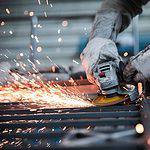Draft tube is a connecting pipe of constantly increasing area, from runner exit to tail race. Draft tube is one of the important parts of a hydro turbine, which is used to transform water into energy.
The purposes of using draft tube is
- To transform dynamic pressure to static pressure.
- With its increasing area helps in reducing cavitation effect.
- To convert residual kinetic energy of flowing water from rotor outlet into pressure energy.
Effect of Cavitation:
- Cavitation noise.
- Cavitation bubbles block flow of water through reduced cross section area.
- Erosion of material with short lifetime.
Draft Tube :
Types:
Based upon the shape and dimension at the inlet and outlet drafts tubes are of different types
- Simple elbow draft tube
- Elbow draft tube with varying cross section
- Moody spreading draft tube
- Conical diffuser draft tube or straight divergent draft tube

1.Simple Elbow Draft Tube
In this type of draft tube the shape of the tube is elbow and the cross section area remains same throughout the length of draft tube. The inlet and outlet of the draft tube are circular shaped.
Used at the places of low head.
Used when the turbine is to be placed close to the tail race.
Efficiency of this type of draft tube is about 60%.
2. Elbow Draft Tube with Varying Cross Section :
It is an improvement of simple elbow draft tube. In this type of draft tube the inlet is circular shaped and where as the outlet is rectangular shaped. The cross section area changes from circular to rectangular from inlet to outlet.
Outlet of draft tube should be suited below tail race.
Generally used in Kaplan turbine.
Efficiency of this type of draft tube is about 70%.
3. Moody Spreading Draft Tube :
In this type of draft tube there will be one inlet and two outlets. Inlet and both the outlets of draft tube are circular.
Moody spreading draft tube is also called as HYDRA
The central solid core will divide both the outlets.
Used for reducing swirling action of water.
Efficiency of this type of draft tube is about 88%.
4. Conical Diffuser Draft Tube:
In this type of draft tube the flow path way is straight and divergent. Cross sectional area varies from beginning to ending of draft tube.
It is used for low specific speed and vertical shaft Francis turbine.
Cone angle is less than 100. If the cone angle is high cavitation occurs.
Efficiency of this type of draft tube is about 90%.
Function of Draft Tube:
The main function of draft tube is to decelerate the velocity and increase the pressure of the fluid flowing from the runner exit to tail race.
Water enters into the penstock and strikes the turbine vanes and reduces its pressure. To reduce the velocity of water and to increase the pressure of water before entering the tail race a pipe of gradually increasing cross sectional area is used. Draft tube increases the pressure of water to the atmospheric pressure.

Applying Bernoulli’s equation at section 1 – 1 and 2 – 2
[Pressure head + velocity head + elevation head] 1 – 1 = [pressure head + velocity head + elevation head] 2 – 2
Let
P1 = pressure of fluid at section 1-1 (inlet of draft tube)
V1 = velocity of fluid at section 1-1 (inlet of draft tube)
Similarly
P2 = pressure of fluid at section 2-2 (outlet of draft tube)
V2 = velocity of fluid at section 2-2 (outlet of draft tube)
ρ = density of flowing fluid
g = gravitational force
hf = loss of head (energy) in draft tube
Hs = vertical height of draft tube above the tail race
y = distance of bottom of draft tube from tail race.
Pa = atmospheric pressure of fluid.
( P1 / ρg ) + ( V12 / 2g ) + ( Hs + y ) = ( P2 / ρg ) + ( V22 / 2g ) + ( 0 + hf )
( P1 / ρg ) = ( P2 / ρg ) – ( Hs + y ) + ( V22 / 2g ) – ( V12 / 2g ) + hf
Pressure head at section 2 – 2 is equal to atmospheric pressure head and distance y.
( P2 / ρg ) = ( Pa / ρg ) + y
( P1 / ρg ) = ( Pa / ρg ) + y – Hs – y + ( V22 / 2g ) – ( V12 / 2g ) + hf
( P1 / ρg ) = ( Pa / ρg ) – Hs + ( V22 / 2g ) – ( V12 / 2g ) + hf
Converting the equation for our requirement (i.e., in the middle of R.H.S taking “-” common)
( P1 / ρg ) = ( Pa / ρg ) – Hs – [ ( V12 / 2g ) – ( V22 / 2g ) – hf ]
In the above equation [ ( V12 / 2g ) – ( V22 / 2g ) – hf ] is called kinetic head.
Here [ ( V12 / 2g ) – ( V22 / 2g ) ] is the dynamic head.
From the above equation we can write
( P1 / ρg ) < ( Pa / ρg )
So P1 < Pa
Pressure head at inlet of draft tube or outlet of turbine is less than the atmospheric pressure. So the net head on turbine with draft tube is increased.
Efficiency of Draft Tube:
Efficiency of draft tube Ƞd = Actual conversion of kinetic head into pressure head to the kinetic head at inlet of the draft tube.
Ƞd = (Actual conversion of kinetic head into pressure head) / (kinetic head at inlet of the draft tube)
Ƞd = [ ( V12 / 2g ) – ( V22 / 2g ) – hf ] / ( V12 / 2g )
Actual conversion of kinetic head into pressure head = [ ( V12 / 2g ) – ( V22 / 2g ) – hf ]
Theoretical conversion of kinetic head into pressure head = [ ( V12 / 2g ) – ( V22 / 2g ) ]
Some of the reasons to use draft tube are
- In turbines with low head especially in reaction turbines the pressure of water at runner exit will be less than atmospheric pressure. The pressure of water drops to sub atmospheric pressure. But the water outside is having a positive pressure of atmospheric pressure (chance of air entrapment and could cause cavitation). In practical significance water flows from higher pressure value to lower pressure value. There may be a chance of water to enter into tail race from its exit. This will cause the turbine fail to work.
- In order to increase the net available head on the turbine (to flow more water to get more energy) either runner should be placed lower or tail race should be lowered. Lowering the tail race is not a good idea due to space limitations. In such cases draft induces the negative pressure at runner outlet. (efficiency increases)
- To convert large portion of kinetic energy rejected at the outlet of turbine into pressure energy to reduce losses.
Merits of Draft Tube :
- Provides negative head at the outlet of the runner to increase the net available head on the runner.
- Turbine may be placed above the tail race without any loss of net head.
- Prevents the splashing of water coming out of runner and guides the water to the tail race.
NOTE :
The word “TAPERED” is incorrect “GRADUALLY INCREASING AREA OF CROSS SECTION” is correct.
Gradually or Constantly increasing area means constantly decreasing velocity that means constantly increasing pressure.
The aim of draft tube is water should gain pressure in due course of passage time. ( it is not possible in cylindrical pipe. )
The efficiency of draft tube depends upon the shape of the draft tube.
Pressure at the exit of runner is suction pressure and it should not be reduced to vapour pressure.
This is all about draft tube types, purpose, function, efficiency etc. If you have any doubt ask by commenting. If you like this article, don’t forget to share it on social networks. Subscribe our website for more informative articles. Thanks for reading it.






